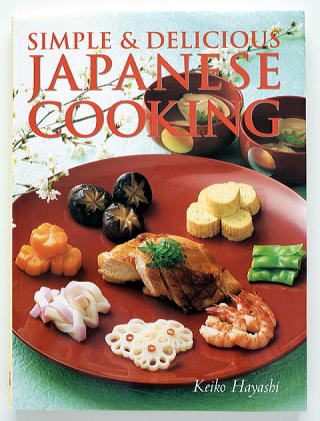 Born and raised in a gourmet family in an epicurean city called Osaka,
Japan, Keiko Hayashi started her career as a teacher of English at a senior
high school near Kyoto, where she finished her college education majoring
in English literature. Born and raised in a gourmet family in an epicurean city called Osaka,
Japan, Keiko Hayashi started her career as a teacher of English at a senior
high school near Kyoto, where she finished her college education majoring
in English literature. Four years later, she and her family moved to Tokyo following her husband's relocation. There, she started to make bento box lunch for her husband everyday. The bentos she made were nothing gorgeous or fancy but unique and full of creative ideas.  One day, a business friend of her husband from a publishing company happened
to be with Keiko's husband at lunch time, and was offered to share his bento. The unique bento not only attracted special attention of the person from the publisher,
but surprised him by the fact that she made the creative and different bento everyday.On his return to his office, this person reported what he saw
and experienced to the editorial group of Women's Magazine Department of
his company. Soon, an editor of the best-selling Women's Magazine called
Keiko and asked her to make three unique box-lunches for spring issue of
the magazine. One day, a business friend of her husband from a publishing company happened
to be with Keiko's husband at lunch time, and was offered to share his bento. The unique bento not only attracted special attention of the person from the publisher,
but surprised him by the fact that she made the creative and different bento everyday.On his return to his office, this person reported what he saw
and experienced to the editorial group of Women's Magazine Department of
his company. Soon, an editor of the best-selling Women's Magazine called
Keiko and asked her to make three unique box-lunches for spring issue of
the magazine.Believe it or not, this small happening back in 1969 was the trigger of the subsequent over 30 years of extensive cooking/creative recipe writing career. She started to spend much more time in her own kitchen and disciplined herself to become a professional. When she came up with something that satisfied herself after trials and errors, she entertained her friends, husband's colleagues and his guests with her creation for their comments and criticisms . After the unexpected surprise debut in the bet-selling women's magazine with the longest history in Japan, the recipes and pictures of her creative dishes were published in a variety of women's, health, baby's magazines of other publishers, major newspapers, radio, TV and so forth. As her reputation spread, Keiko's activities expanded to teach cooking at a popular culture center in downtown Tokyo. Furthermore, she was asked to give Japanese cooking lessons to wives of some American Embassy people in Tokyo. Although she was not a trained cook or had not taught in English, her curiosity prompted her to say "Yes," responding to the foreign ladies who were in real earnest in learning Japanese cooking and culinary culture. Thus, Keiko's cooking class for foreign residents in Tokyo was born in early 70's, and, to her surprise, she till continues it today.  Her own unique recipes as well as traditional ones in her style, have been made into two books in English: "Try It, You'll Love IT," and "Simple And Delicious Japanese Cooking." The latter was awarded with "The best Recipes Book In The World" in 2000 from Gourmand World Cookbook Awards. Her own unique recipes as well as traditional ones in her style, have been made into two books in English: "Try It, You'll Love IT," and "Simple And Delicious Japanese Cooking." The latter was awarded with "The best Recipes Book In The World" in 2000 from Gourmand World Cookbook Awards.Keiko still actively creating new recipes and test them in her classes for students from various parts of the world as well as from Japan. She keeps those recipes that she found her students liked best, refines them to make them into another book. She now focuses on the dishes of seafood, vegetables, and desserts for those who are conscious of health and happy, long life.As soon as a publisher that may be interested has been identified, all the manuscripts are ready for print. Those who are interested in her cooking class, can get the information by clicking the following URL. |